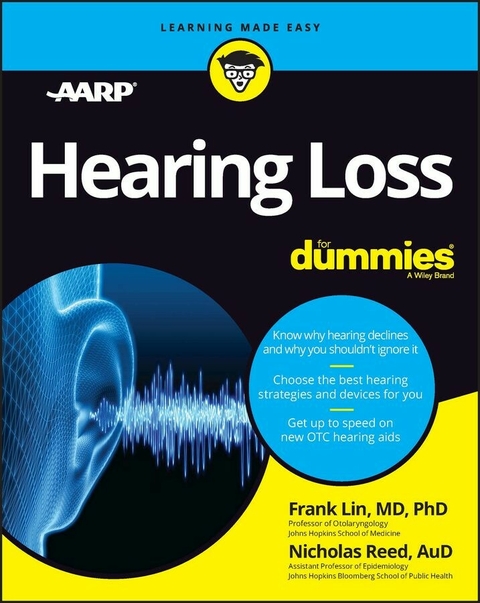
Hearing Loss For Dummies
John Wiley & Sons Inc (Verlag)
978-1-119-88057-8 (ISBN)
With new advice on just-released over-the-counter hearing aids
Hearing loss can be frustrating, but in fact it’s common and treatable. Hearing Loss For Dummies, written by top experts in the field in collaboration with AARP, walks you through how to get the help you need to clearly hear the sounds of life—whether you’re at home, at work, or out and about. And hearing health is critical: Hearing loss can increase your risk of falls and injuries, isolation and depression, and even cognitive decline and dementia.
Authors Frank Lin and Nicholas Reed at the Johns Hopkins School of Medicine lay out the steps to hearing health:
- Understanding how hearing works — and how it changes as we age
- Finding specialists you can trust
- Determining whether you need testing and, if so, where to turn
- Learning practical solutions for hearing better at home, at work, on the phone, and in restaurants and theaters
- Choosing the right hearing aid, including just-approved over-the-counter hearing aids, and getting them adjusted to work for you
- Exploring the pros and cons of cochlear implants and other surgical options
- Covering the costs of hearing health care
If you’re concerned about your own or a friend or relative’s hearing, this is the one book you’ll need. For what can seem like a complicated, stressful and lengthy process, Hearing Loss For Dummies tackles the topic head-on and provides you with expert guidance to put your mind at ease on the path to better hearing.
Frank R. Lin, MD, PhD, is the Director of the Cochlear Center for Hearing and Public Health.
Nicholas S. Reed, AuD, is a clinical audiologist and an assistant professor at Johns Hopkins University.
Introduction 1
About This Book 2
Foolish Assumptions 2
Icons Used in This Book 3
Beyond the Book 4
Where to Go from Here 4
Part 1: Understanding Hearing Loss 5
Chapter 1: Cheers to Your Ears! 7
Understanding Why Hearing Loss Happens 8
Hearing takes place over two steps 8
Hearing loss happens as the inner ear wears out 8
Factors that affect your hearing over time 9
Putting Hearing Loss in Context 10
Hearing loss happens to everyone 10
How hearing loss impacts our health and well-being 10
The benefits of addressing hearing loss 12
What You Can Do about Hearing Loss 12
Know your hearing 12
Using communication strategies 14
Hearing technologies 15
Getting the Support You Need 17
Chapter 2: Understanding How Hearing Works 19
What Is Sound? 20
How sound gets its sound 20
What sound “looks” like 21
To Hear, You Need Your Ear! 23
External ear 24
Middle ear 24
Inner ear 25
Hearing with Your Brain 26
Two ears are better than one 27
It’s not just sound — “seeing” what you hear 28
Context matters 28
Pinpointing Where the System Can Break Down 29
When sound quality is poor 29
When the sound can’t get in 29
When the inner ear garbles the encoding of sound 30
When the brain struggles to process sound 31
Experiencing Trouble Hearing 31
Chapter 3: Looking at Types of Hearing Loss and Minimizing Risk 33
Discovering Why Hearing Gets Worse Over Time 34
Knowing the Causes of Hearing Loss Over Time 34
Biological aging processes 35
Cardiovascular risk factors 35
Genetics 36
Minimizing Your Risk for Hearing Loss 37
Noise exposure 37
Keeping your ear heart-healthy 40
Considering Other Conditions That Affect Hearing 41
The almighty ear infection 41
Earwax — ick! 43
Diseases of the ear 45
Medications 45
Causing Tinnitus 46
Tinnitus explained 46
Tinnitus triggers 47
Chapter 4: Realizing What You Lose When You Can’t Hear 49
Communicating Is Like a Game of Catch 49
Hearing loss affects how well you can play catch 50
Why playing catch is sometimes easier or harder 50
Communication and hearing loss in critical situations 51
Watching for a Reduction in Social Interaction 53
Monitoring Mental and Emotional Health 53
What is loneliness? 54
How loneliness hurts your health 54
Looking at hearing loss and loneliness 55
Losing Physical Abilities 55
How hearing affects your physical abilities 55
How hearing affects your balance 56
Dealing with a Decline in Cognitive Function 57
What are cognition and dementia? 57
Hearing loss and dementia — say what? 58
Hearing aids to prevent dementia? 59
Part 2: Evaluating How You Hear 61
Chapter 5: Recognizing Hearing Loss 63
Missing the Signs of Hearing Loss 64
Barely noticeable changes 64
Everyone else is mumbling! 64
Compensating until you can’t 64
Don’t know what you’re missing 65
Sussing Out Whether Your Hearing Has Declined 65
Knowing When to Get Your Hearing Tested 66
Screening, testing, and diagnostics 67
Establishing a baseline 67
Getting regular hearing checkups 69
Knowing when you should get tested immediately 69
Shrugging Off the Stigma of Hearing Loss 70
Caring about your hearing above what other people think 71
It’s okay to wear hearing aids 71
The stigma is fading 72
Chapter 6: Seeing a Hearing Loss Professional and Getting Tested 75
Getting to Know the Hearing Care Team 76
Audiologist: Assessing and addressing hearing loss 76
Otolaryngologist: Comprehensive medical care for the ear 77
Hearing instrument specialist: Focusing on the hearing aid 78
The most important team member: You! 78
Preparing for the Assessment 78
It all starts with history 79
To know the ear is to see the ear 80
Knowing What to Expect during the First Part of the Diagnostic Hearing Test 80
Picking up on pure-tones: “Listen for the beeps” 81
Testing your hearing with air and bone conduction 82
Checking Out Other Hearing Assessment Measures 85
Testing whether sound is getting to the middle and inner ears 85
Measuring your speech understanding 86
Evaluating how the brain reacts to sound 88
Testing when sound is clear but difficult to understand 89
One and Done or a Regular Occurrence? 89
Chapter 7: Making Sense of Your Hearing Test Results 91
Understanding the Importance of Reading Results 92
Introducing the Audiogram: What Does That Graph Mean? 92
Audiogram 101 93
Hearing loss categories on the audiogram 94
Defining Hearing Loss with the Audiogram 96
The Xs and Os of hearing 96
Diving into details of your hearing loss 97
Using the audiogram to make sense of how hearing loss affects you 98
The Hearing Number: An Easier Way to Make Sense of Your Hearing 101
Where the hearing number comes from 101
What the hearing number means to you 102
Does my hearing number change? 102
What to do with your hearing number 103
How to get your hearing number 104
Guiding Your Hearing Health Journey with Your Results 105
Monitor changes in hearing 106
Use it or lose it 106
Part 3: Taking Charge of Your Hearing 107
Chapter 8: Fine-Tuning Your Life to Hearing Loss 109
Discovering Where Adjustments Can Be Made 110
Finding No-Tech Communication Strategies for Everyday Situations 110
Get close 110
Be face-to-face 111
Summarize and repeat (“Huhs” don’t help!) 111
Optimizing Your Listening Environment 112
Turn down any background sounds 112
Avoid reverberation 113
Pick the right restaurants 113
Using Everyday Technology Strategies 115
Closed captioning 115
Voice over internet protocol (VOIP) calls and videocalls 116
Speaking Up for Yourself 117
Ways to identify that you’re having trouble hearing 118
Giving the speaker a solution 118
Practicing self-advocacy 119
Reading about others with hearing loss 120
Seeking Out Support Groups 120
Chapter 9: Looking at How Hearing Aids Work 123
Understanding Hearing Aids 123
The anatomy of a hearing aid: How hearing aids work 124
Hearing aids don’t make all sounds louder 125
Enhancing clarity of sound with hearing aids 126
Checking Out the Different Styles of Hearing Aids 128
Behind-the-ear 128
In-the-ear 132
Weighing the pros and cons of hearing aid styles 133
Chapter 10: Understanding Your Hearing Aid Options 135
Discovering Where to Start for Your Needs 136
Knowing Two Ears Means Two Hearing Aids 136
Is using only one hearing aid harmful? 137
The exception to the rule 137
Choosing a Prescription Hearing Aid 138
Working with a professional to purchase hearing aids 138
Customizing your hearing aids with a professional 140
Navigating the Over-the-Counter Hearing Aid Pathway 143
The basics of OTC hearing aids 143
Deciding where to buy your OTC hearing aid 146
How to choose from too many options 147
When to seek professional assistance with OTC hearing aids 148
Choosing Basic or Premium Hearing Aids 149
Chapter 11: You’ve Got Hearing Aids: Now What? 151
Setting Expectations Is Key 151
Getting Used to Your Hearing Aids 153
Practice makes perfect 153
Activities to get used to hearing aids 154
Trust the process 156
Adjusting and Manipulating Your Hearing Aids 156
Working with batteries 157
Putting hearing aids in your ears 158
Changing the sound of hearing aids 159
Caring for and Maintaining Your Hearing Aids 160
Establishing a maintenance routine 160
Avoiding situations that are bad for your hearing aids 163
Troubleshooting common problems with hearing aids 164
Knowing When It’s Time to Upgrade Your Hearing Aid to a New Generation 165
Chapter 12: Technology That Boosts Hearing and Hearing Aids 167
Captioning Your Life 168
Using captions on TV 168
Obtaining and using captioned phones (They’re free!) 168
Captioning in video conference calls 169
CART for live sessions 169
Outfitting Your Home with Hearing-Friendly Tech 170
Talking about Integration Technology 171
Working with Bluetooth and hearing aids 171
Navigating smartphone apps 172
Checking Out Hearing Aid Accessories 172
Using a remote control 173
Trying out a remote microphone 173
Connecting to the TV 175
Streaming all your devices 177
The Mighty Telecoil: Getting a Direct Connection to Sound Signals 178
Looping in telecoils in public spaces 178
Telecoils and telephones 180
Telecoil with FM and infrared systems 180
Has Bluetooth replaced telecoils? (No!) 181
Sounding Out Personal Amplifiers 182
Demystifying PSAPs versus hearing aids 182
The reality of using PSAPs 183
Navigating the unregulated amplifier marketplace 183
Will OTC hearing aids replace PSAPs? 184
Chapter 13: Medical and Surgical Treatment of
Hearing Loss 185
Looking into Medications That Treat Hearing Loss 186
Using steroids for sudden hearing loss 186
Taking medications for problems with the external or middle ear 187
Checking Out Different Surgeries for Hearing Loss 188
Surgeries for conductive hearing loss 188
Surgery for sensorineural hearing loss 189
Other surgically implantable hearing devices 192
Part 4: Supporting Hearing Needs 195
Chapter 14: Helping Those with Hearing Loss 197
Noting How Hearing Loss Influences Relationships 198
Understanding Hearing Loss from the Other Side 198
Emotions that often accompany hearing loss 199
Realizing hearing aids don’t cure hearing loss 199
Discovering How to Be a Good Communication Partner 200
Move close and speak face-to-face 201
Repeat and reword 201
Speak slowly and clearly 201
Get your partner’s attention before speaking 202
Choose the right environments for conversations 202
Using technologies to help communication 202
Figuring Out Hearing and Communication Needs 203
Noticing non-verbal cues 203
Using the hearing number as a guide 204
Supporting People on Their Hearing Care Journey 204
Chapter 15: Paying for Hearing Care 207
Paying for Hearing Services 207
Hearing testing 208
Medical and surgical evaluation 208
Hearing rehabilitative support services 208
Breaking Down Hearing Aid Costs 210
Weighing out-of-pocket-options 211
Checking on insurance coverage options for hearing aids 212
Looking to the future: Over-the-counter hearing aids 215
Tapping into Veterans Administration benefits 216
Seeking charitable foundations 216
Using health savings and flexible spending accounts 216
Chapter 16: Your Rights as Someone with Hearing Loss 217
Looking into Disability and Hearing Loss 218
How do you define disability? 218
How to follow a social model of disability 218
Understanding the Role of the Americans with Disabilities Act 220
Discouraging disability discrimination in the workplace 220
Accessibility and accommodations in public 220
Focusing on telephones and television 221
Navigating the Social Security Administration Disability Benefits 221
Determining hearing loss for Social Security disability benefits 222
Considering Claims for SSDI 224
Looking at Supplemental Security Income 225
Initiating a claim 225
Advocating to Advance Your Hearing Rights 225
Advocating for change 225
Improving organization policy 226
Part 5: The Part of Tens 227
Chapter 17: Ten (Plus One) Considerations When Purchasing Hearing Aids 229
Paying More Does Not Guarantee Better Outcomes 230
Selecting from the Many Styles 230
Choosing a Brand 232
Seeking Hearing Aids with Telecoils 233
Powering Your Hearing Aid with Rechargeable Batteries 233
Deciding on Open or Closed Fit 234
Insuring Your Hearing Aids with a Trial Period Warranty 234
Customizing and Supporting Your Hearing Aids 235
Monitoring Health with Hearing Aids 236
Accessorizing Your Hearing Aids 236
Setting Expectations and Practicing 237
Chapter 18: Ten Everyday Strategies to Hear Better 239
Get Close and Face-to-Face 239
Recognize the Hearing Needs of the People You’re Talking With 240
Turn Down the Background Sounds 240
Don’t Just Ask “Huh?” 241
Choose Good Listening Environments 241
Use Closed Captioning 241
Wear Headphones When Listening to Music or Watching Media 242
Use Video Calls or VOIP When Calling Others 242
Customize the Hearing and Sound Features on Your Smartphone 243
Know Your Hearing Number 243
Chapter 19: Ten Myths about Hearing Loss 245
Hearing Loss Is Just Part of Getting Older so It Can’t Be That Important 245
My Hearing Is Fine; It’s Just That Everyone Is Mumbling 246
Trouble Hearing? Just Have People Shout! 246
I’ll Wait to Get My Hearing Tested Until I Notice a Problem 246
I’ll Address My Hearing Loss Later When It Gets Really Bad 247
I Have Hearing Loss Now I Need Hearing Aids? 247
Hearing Aids Fix Your Hearing 248
I Can Just Put in My Hearing Aids and They’ll Work Fine 248
A Cochlear Implant Is Only for People Who Are Completely Deaf 249
I Should Keep My Hearing Loss to Myself 249
Index 251
| Erscheinungsdatum | 26.08.2022 |
|---|---|
| Verlagsort | New York |
| Sprache | englisch |
| Maße | 188 x 237 mm |
| Gewicht | 558 g |
| Einbandart | kartoniert |
| Themenwelt | Sachbuch/Ratgeber ► Gesundheit / Leben / Psychologie ► Krankheiten / Heilverfahren |
| Sachbuch/Ratgeber ► Gesundheit / Leben / Psychologie ► Lebenshilfe / Lebensführung | |
| Medizin / Pharmazie ► Medizinische Fachgebiete ► HNO-Heilkunde | |
| ISBN-10 | 1-119-88057-2 / 1119880572 |
| ISBN-13 | 978-1-119-88057-8 / 9781119880578 |
| Zustand | Neuware |
| Haben Sie eine Frage zum Produkt? |
aus dem Bereich



